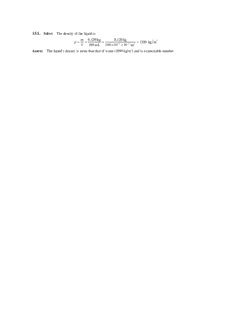
15.1. Solve PDF
Preview 15.1. Solve
15.1. Solve: The density of the liquid is m 0.120 kg 0.120 kg ρ= = = =1200 kg m3 V 100 mL 100×10−3×10−3 m3 Assess: The liquid’s density is more than that of water (1000 kg/m3) and is a reasonable number. 15.2. Solve: The volume of the helium gas in container A is equal to the volume of the liquid in container B. That is, V = V . Using the definition of mass density ρ=m V, the above relationship becomes A B mA = mB ⇒ mHe = 7000 mHe ⇒ρ =(7000)ρ =(7000)(0.18 kg m3)=1260 kg m3 ρ ρ ρ ρ B He A B He B Referring to Table 15.1, we find that the liquid is glycerine. 15.3. Model: The density of water is 1000 kg/m3. Visualize: Solve: Volume of water in the swimming pool is V =6 m×12 m×3 m− 1(6 m×12 m×2 m)=144 m3 2 The mass of water in the swimming pool is ( )( ) m=ρV = 1000 kg m3 144 m3 =1.44×105 kg 15.4. Model: The densities of gasoline and water are given in Table 15.1. Solve: (a) The total mass is m =m +m =0.050 kg + 0.050 kg = 0.100 kg total gasoline water The total volume is m m 0.050 kg 0.050 kg V =V +V = gasoline + water = + =1.235×10−4 m3 total gasoline water ρ ρ 680 kg m3 1000 kg m3 gasoline water m 0.100 kg ⇒ρ = total = = 810 kg m3 avg V 1.235×10−4 m3 total (b) The average density is calculated as follows: m =m +m =ρ V +ρ V total gasoline water water water gasoline gasoline ( )( ) ρ V +ρ V 50 cm3 1000 kg/m3 +680 kg/m3 ⇒ρ = water water gasoline gasoline = =840 kg/m3 avg V +V 100 cm3 water gasoline Assess: The above average densities are between those of gasoline and water, and are reasonable. 15.5. Model: The density of sea water is 1030 kg/m3. Solve: The pressure below sea level can be found from Equation 15.6 as follows: ( )( )( ) p= p +ρgd =1.013×105Pa+ 1030 kg m3 9.80 m s2 1.1×104 m 0 =1.013×105 Pa+1.1103×108 Pa=1.1113×108 Pa=1097 atm where we have used the conversion 1 atm=1.013×105 Pa. Assess: The pressure deep in the ocean is very large. 15.6. Model: The density of water is 1,000 kg/m3 and the density of ethyl alcohol is 790 kg/m3. Solve: (a) The volume of water that has the same mass as 8.0 m3 of ethyl alcohol is m m ρ V 790 kg m3 ( ) V = water = alcohol = alcohol alcohol = 8.0 m3 =6.32 m3 water ρ ρ ρ 1000 kg m3 water water water (b) The pressure at the bottom of the cubic tank is p= p +ρ gd: 0 water p=1.013×105 Pa + (1000 kg m3)(9.80 m s2)(6.32)13 =1.194×105 Pa where we have used the relation d =(V )13. water 15.7. Visualize: Solve: The pressure at the bottom of the vat is p= p +ρgd =1.3 atm. Substituting into this equation gives 0 1.013×105 Pa+ρ(9.8 m s2)(2.0 m)=(1.3)(1.013×105)Pa⇒ρ=1550.5 kg m3 The mass of the liquid in the vat is m=ρV =ρπ(0.5 m)2d =(1550.5 kg m3)π(0.5 m)2(2.0 m)=2440 kg 15.8. Model: The density of oil ρ =900 kg m3 and the density of water ρ =1000 kg m3. oil water Visualize: Solve: The pressure at the bottom of the oil layer is p = p +ρ gd , and the pressure at the bottom of the water 1 0 oil 1 layer is p = p +ρ gd = p +ρ gd +ρ gd 2 1 water 2 0 oil 1 water 2 ⇒ p =(1.013×105 Pa)+(900 kg m3)(9.80 m s2)(0.50 m)+(1000 kg m3)(9.80 m s2)(1.20 m)=1.18×105 Pa 2 Assess: A pressure of 1.18 × 105 Pa = 1.16 atm is reasonable. 15.9. Model: The density of seawaterρ =1030 kg m2. seawater Visualize: Solve: The pressure outside the submarine’s window is p = p +ρ gd, where d is the maximum safe out 0 seawater depth for the window to withstand a force F. This force is F A= p − p , where A is the area of the window. out in With p = p, we simplify the pressure equation to in 0 F F 1.0×106 N pout − p0 = A =ρseawatergd⇒d = Aρ g d = π(0.10 m)2(1030 kg m2)(9.8 m s2) =3153 m seawater Assess: A force of 1.0 × 106 N corresponds to a pressure of F 1.0×106 N ρ= = =314 atm A π(0.10 m)2 A depth of 3 km is therefore reasonable. 15.10. Visualize: We assume that the seal is at a radius of 5 cm. Outside the seal, atmospheric pressure presses on both sides of the cover and the forces cancel. Thus, only the 10 cm diameter opening inside the seal is relevant, not the 20 cm diameter of the cover. Solve: Within the 10 cm diameter area where the pressures differ, F = p A F = p A to left atmos to right gas where A=πr2 =7.85×10−3 m2 is the area of the opening. The difference between the forces is F − F =(p − p )A=(101,300 Pa−20,000 Pa)(7.85×10−3 m2)=639 N to left to right atmos gas Normally, the rubber seal exerts a 639 N force to the right to balance the air pressure force. To pull the cover off, an external force must pull to the right with a force ≥639 N.
Description: